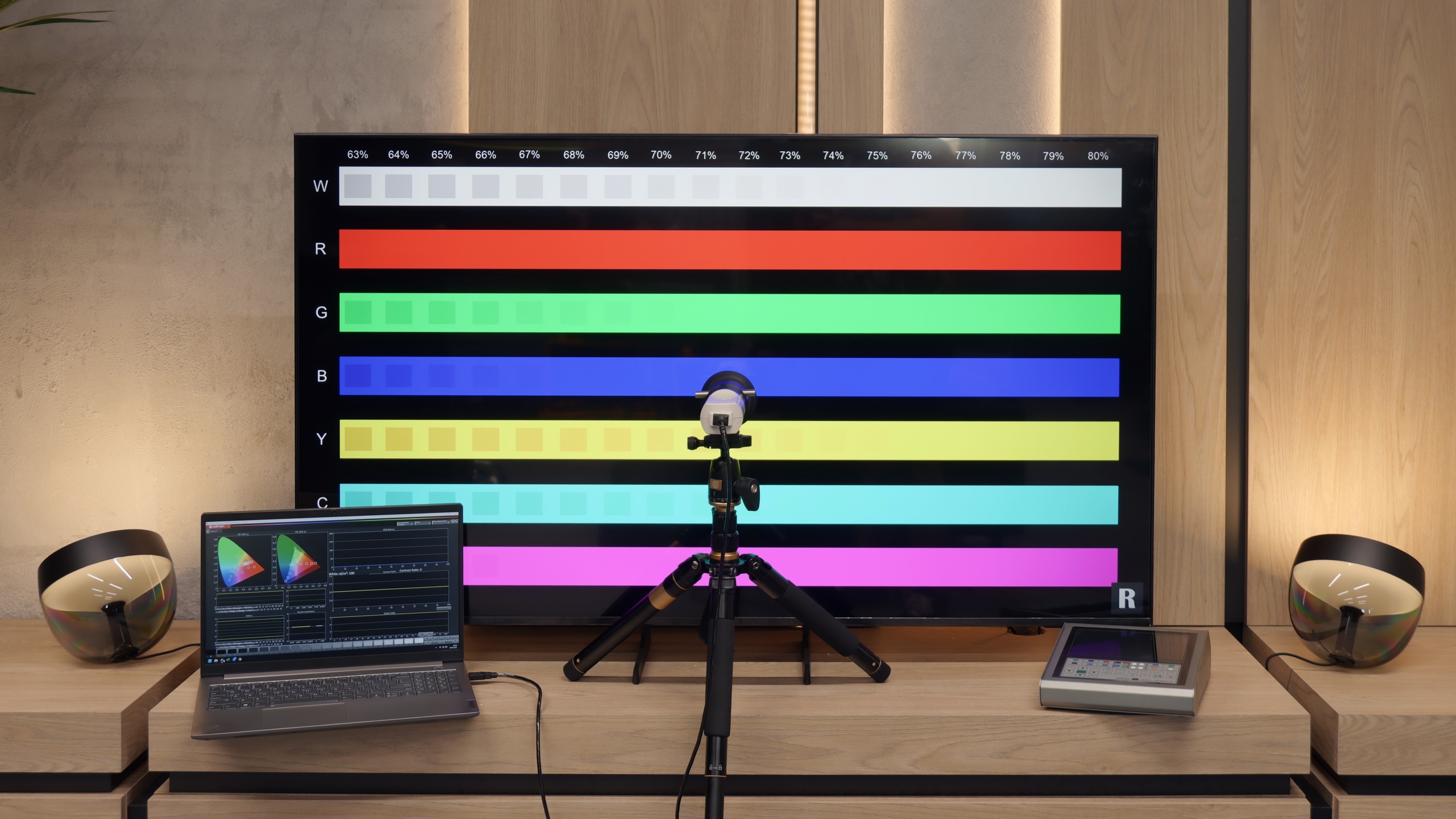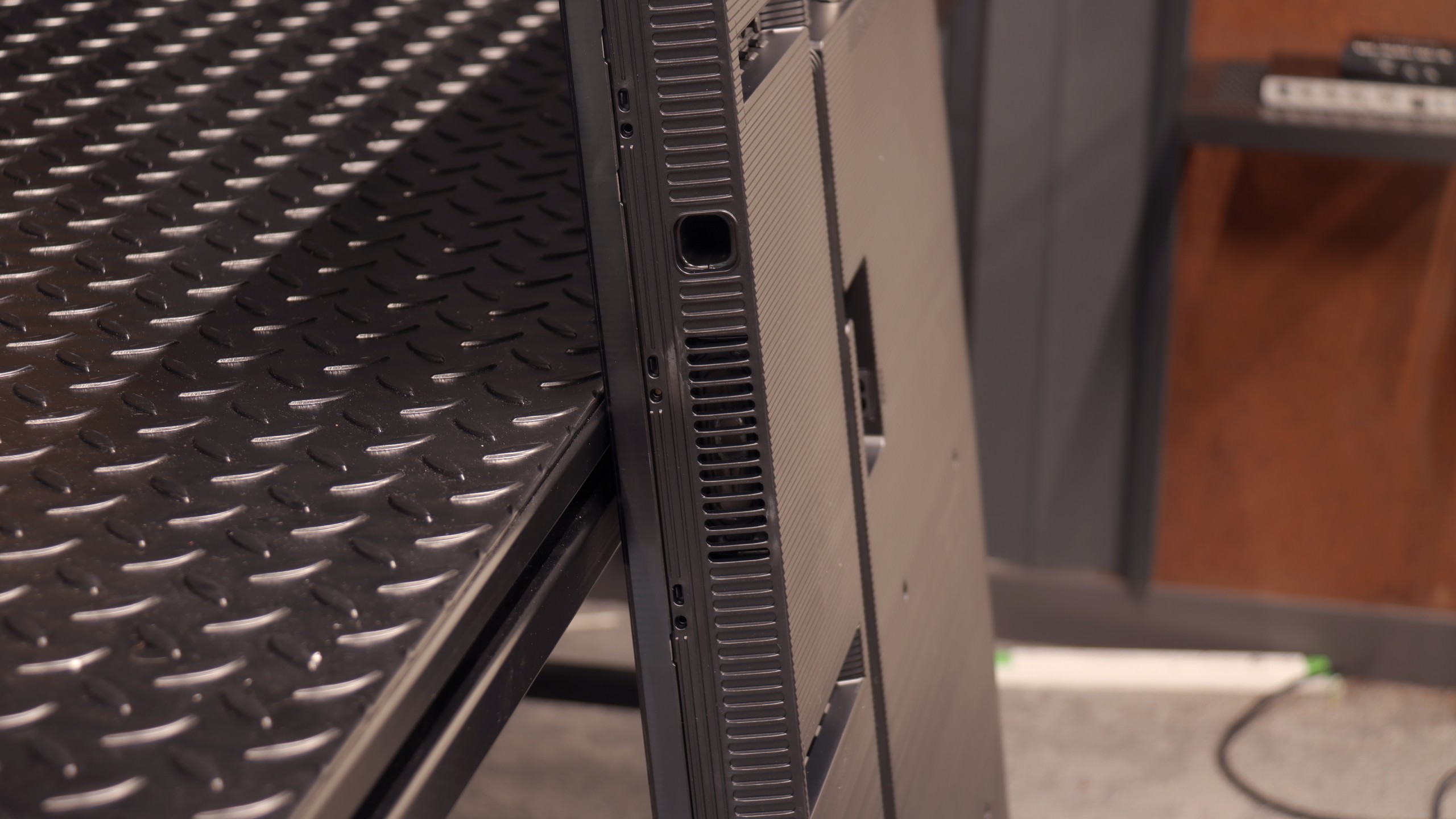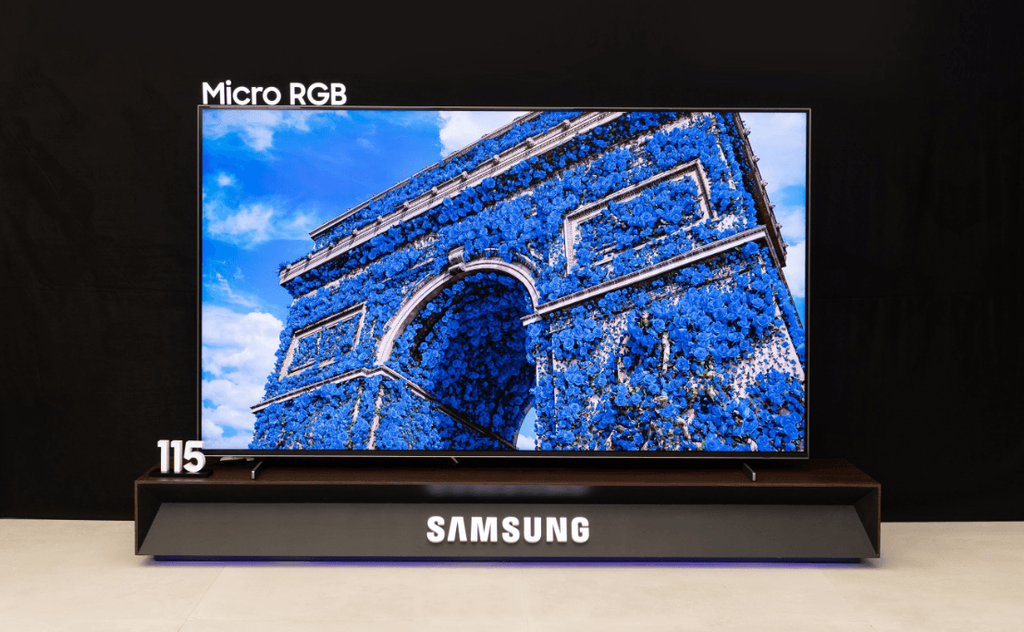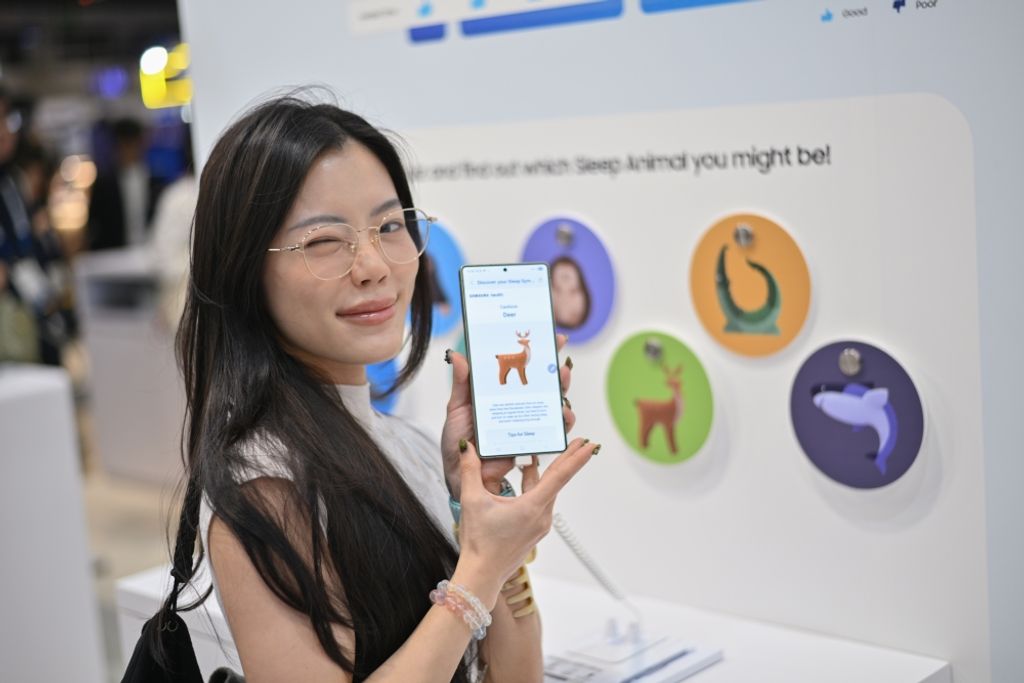- Matching (Score)
- Our verdict
- Competing TVs
- TV appearance
- Where to buy
- Contrast and black detail
- HDR effect quality
- Factory color reproduction
- Color reproduction after calibration
- Smoothness of tonal transitions
- Image scaling and smoothness of tonal transitions
- Blur and motion smoothness
- Console compatibility and gaming features
- Input lag
- Compatibility with PC
- Viewing angles
- TV efficiency during daytime
- TV features
- Apps
- Playing files from USB
- Sound
- Details about the matrix
Panel type: LCD VA Refresh rate: 60Hz Brand: SAMSUNG Resolution: 3840x2160 System: Tizen Model year: 2025
In the world of Samsung's QLEDs, the Q7F (2025) plays a relatively important role. It is the cheapest model in this family in the current offering of the Korean manufacturer. Of course, we won't find a 120 Hz panel or advanced features for gamers here, but... it makes up for that with a solid Tizen system and pleasantly saturated colours worthy of the QLED filter. The question is, how does it perform in everyday use? And more importantly, does a cheap QLED even make sense? You'll find out in this review!

SAMSUNG Q7F - Our verdict
5.8
Overall rating
Samsung Q7F is the cheapest model from the manufacturer in the QLED line, and it must be said that a few advantages can easily be pointed out here. After calibration, the colours look really good, and the additional QLED filter ensures that the hues are more saturated than in typical budget LCD televisions. Additionally, there’s a VA panel that offers quite decent native contrast. It’s certainly not on the level of top-tier models, but in everyday viewing, it does the job. However, the biggest plus is the Tizen system, Samsung’s flagship offering. It runs smoothly, is comprehensive, provides access to a plethora of applications and add-ons, and allows for easy integration of the television into the SmartThings ecosystem to control other devices in the home. And essentially, that’s where the list of positives ends, as the longer you use the Q7F, the more apparent it becomes that this is a product that is quite unfinished. It’s not just about the panel itself with its low brightness and mediocre image quality in HDR films, but also about the lack of features that usually worked flawlessly in Samsung devices. The manufacturer claims the presence of VRR and HGiG, but in practice, they are of no use, making it difficult to recommend the television even to casual gamers. For regular TV viewing, it doesn’t perform the best either because the digital image processing is at best average, and the feature for improving tonal transitions, which usually works well for Samsung, is practically ineffective here. The Q7F is a piece of equipment that can only be recommended to those looking for a television with two slogans on the box: “QLED” and “good Smart TV”. The rest get a rather bland product that lacks a lot to even compete with other more budget-friendly offerings. It’s a shame because usually, the term "QLED" in Samsung meant something more than just an ordinary television.
Advantages
Solid native contrast (VA Panel)
Vivid colours thanks to the QLED filter
Low input lag (around 10MS)
Robust and smooth Tizen operating system
Compact sleek design with Type C charging
Disadvantages
Very low brightness (only 250 nits in HDR)
Lack of many gaming features including VRR and HGiG – the manufacturer promised something, but in the end, those features are simply not there
Lack of many classic "TV" features like USB recording or PIP
No Dolby Vision
Average digital image processing quality
Movies and series in UHD quality
5.7
Classic TV, YouTube
5.6
Sports broadcasts (TV and apps)
5.4
Gaming on console
6.3
TV as a computer monitor
6.0
Watching in bright light
3.9
Utility functions
7.3
Apps
8.7
Sound quality
5.8
Complete the survey to find out what fits your preferences
SAMSUNG Q7F - Competing TVs in this price range
SAMSUNG Q7F - TV appearance
HDMI inputs: 3 x HDMI 2.0, 0 x HDMI 2.1 Outputs: Toslink (Optical audio), eARC (HDMI), ARC (HDMI) Network Interfaces: Wi-Fi 2.4GHz, Wi-Fi 5GHz, Ethernet (LAN) 100Mbps
Build quality: BuildQuality-Good
Stand type: Legs
Bezel colour: Graphite









Stand: Height adjustment, Base adjustment
Flat design: No
Accessories: Stand
Although the Samsung Q7F (2025) is a rather budget-friendly model, it’s clear that the manufacturer has put effort into its construction. The bezels are slim and narrow – pretty much what Samsung has been using in most of its TVs. The design of the feet is quite clever. Yes, they are plastic, but they offer a lot of adjustment options: you can set them wider or narrower thanks to special recesses in the casing, and you can also lift the TV using built-in spacers – handy if you want to slide a soundbar underneath. The only downside is that the Q7F has become a bit more “bulky” compared to what Samsung usually delivers. When hung on the wall, it will protrude more than the pricier models. This might not be a major flaw, but it’s definitely something that catches the eye immediately. Overall, we rate the appearance a solid four out of five in a school grading scale.
Buy in the best price
Select size:
SAMSUNG Q7F - Contrast and black detail
4.7/10
Local dimming function: No

Result
2,850:1

Result
2,750:1

Result
3,300:1

Result
3,050:1

Result
2,750:1
Visibility of details in the lights:

The Samsung Q7F in the 55-inch size we tested has a VA panel, which immediately translates to decent native contrast. Values around 3000:1 may not be record-breaking, as we know that VA panels are currently being produced with more than double the contrast, but it still performs much better than IPS or ADS panels, where black quickly turns into shades of grey or navy blue. Unfortunately, we won't find typical local dimming zones here, but the manufacturer has added something like global dimming – that is, dimming the whole screen relative to the content. The effect? In most scenes, black looks quite solid, although during nighttime viewing, we will still see that it resembles a dark navy or grey more than true pitch black. Overall, it's alright, but without any fireworks – it's not spectacular, but there's also no drama.
SAMSUNG Q7F - HDR effect quality
3.7/10
Supported formats: HDR10, HDR10+, HLG Color gamut coverage: DCI P3: 92.4%, Bt.2020: 69.2%
Luminance measurements in HDR:

Result
215 nit

Result
225 nit

Result
267 nit

Result
113 nit

Result
250 nit
Unfortunately, the Samsung Q7F is not one of the bright televisions, which directly impacts the quality of HDR films. The peak brightness of the panel is only around 250 nits, which is definitely insufficient for claiming a true cinematic experience. In practice, the HDR content does not differ significantly from classic SDR, making it difficult to talk about any "wow effect" that usually accompanies us when watching such films. During testing of film scenes, the image simply looked dark, and the brightness almost always hovered around the aforementioned 250 nits. The worst performance came from shots with small, intensely glowing elements – the global dimming technique used reacted very aggressively in those cases, dimming the entire screen to maintain the black effect. However, it is worth noting the presence of a QLED coating that broadens the colour spectrum. For a budget QLED model, the Q7F performs quite decently here: the DCI-P3 colour gamut coverage is around 93%, and BT.2020 reaches 70%. This means that despite the low brightness, the colours can still look quite vivid and attractive.
Scene from the movie “Pan” (about 2800 nits)

Scene from the movie “Billy Lynn” (about 1100 nits)

In the case of the Q7F, the situation is quite complex. The brightness is low enough that it's hard to talk about cinematic experiences on par with better screens, but at the same time, it's not fair to say that the picture it produces is completely unattractive. The scene from the film Mr. was vibrant and colourful despite some slight clipping, and the segment with Billy Lynn was also rendered quite well. A large part of this is due to the dynamic tone mapping feature, which is definitely worth turning on. Interestingly, on the Q7F it works inversely compared to most Samsung models. The "static" setting makes the image appear more washed out, while the "active" mode can enliven it and give it a real depth (of course, within the limits of the display's capabilities). It is this feature that largely saves the Q7F in more challenging film scenes, allowing the viewing experience to gain attractiveness despite the limitations of the panel itself.
HDR luminance chart:
HDR luminance
While the effect of burn-in is still occasionally visible, enabling tone mapping makes the picture look significantly better. It's easier to see more shadows and details that simply get lost in static mode. In daily viewing, the difference is substantial enough that this feature can be considered essential. It gets even more interesting with HDR10+ content. This format immediately shows that the Q7F can extract more from the image than might be expected from the panel's specifications alone. In HDR10+ materials, details in challenging scenes become more visible. This can be compared to Dolby Vision, which is unfortunately absent in the Q7F – both solutions work on a similar principle, adjusting the TV's parameters scene by scene, or even frame by frame. Fortunately, HDR10+ has been gaining popularity in recent years – not only among games but also in streaming services. A good example is Netflix, which has recently started supporting this format. This somewhat compensates for the lack of Dolby Vision and makes the Q7F perform acceptably with cinematic content.
Static HDR10

Dynamic: HDR10+

Factory color reproduction
5/10
The reproduction of factory colours in the Samsung Q7F is definitely not one of its strong points. In Filmmaker mode, which theoretically should be closest to neutral, the white balance issue is immediately noticeable. There’s too much red on the screen, while blue is lacking. The effects are very easy to notice – white, instead of being neutral, takes on warm, almost slightly orange tones. In the long run, this makes the entire image appear a bit unnatural, while bright areas of the scene can seem unrealistic. The problems are even more evident in HDR content. The charts show that the TV has significant errors in the Color Checker palette, which results in visible inaccuracies in the real image. In practice, this means that colours are not presented as they should be. The Q7F also heavily manipulates brightness; darker elements are overly boosted, causing them to lose their cinematic feel, while bright parts can be dimmed. This makes the image seem flattened, and contrast, instead of helping to bring out details, only highlights its own limitations. In HDR materials, this is particularly frustrating because every detail matters. In scenes where a subtle play of light and shadow should be felt, the Q7F either overdoes the lighting or, conversely, suppresses elements that should attract the eye. This causes the image to lose its depth, and instead of cinematic realism, we have a rather simplified effect.
Color reproduction after calibration
7.6/10
After professional calibration, we managed to bring the Q7F to order – at least in terms of SDR content. The image in this mode looks really good: the white balance has been set correctly, the colours appear natural, and the errors in the colour palette have dropped to levels practically invisible to the eye. Gamma behaves exemplary, and the only minor flaw remains a slight lightening of smaller elements, which stems from the lack of local dimming. For everyday watching of television or films in standard quality, the Q7F performs surprisingly well.
It was significantly more challenging to tame HDR content. Despite adjusting the white balance, the television still heavily manipulates brightness, causing scenes to appear unnatural – what was meant to be subtly darker can sometimes be overly bright, and the bright parts of the image can occasionally be dimmed. The final effect is better than in factory settings, but it’s clear that the construction limitations of the Q7F do not allow for fully utilising the potential of HDR materials.


SAMSUNG Q7F - Smoothness of tonal transitions
9/10
The fluidity of tonal transitions in the Q7F is really quite good. The gradients are smooth, without harsh steps or artificial divisions that can be quite noticeable in cheaper TVs. Even in more challenging scenes, like the one from The Revenant or the red shot with the actor swimming in water, the picture maintained its quality and simply looked good. If someone is looking very closely, they might notice slight imperfections in extremely demanding moments, but they are subtle enough that most people won’t even notice them. Given this price range, the Q7F performs surprisingly well in terms of gradation, and it's hard to find anything serious to complain about.








Image scaling and smoothness of tonal transitions
5/10
Smooth transition function

Image without overscan on the SD signal

Upscaling and digital image processing in the Q7F is a bit of a rollercoaster. On one hand, we have really nice upscaling – weaker sources look better than you might expect. The image becomes clearer, sharper, and even older films or free-to-air TV hold up well. Samsung has been strong in this area for years, and the Q7F confirms that. On the other hand… things start to get tricky. The TV has a problem with overscan – part of the image is simply cut off, and it doesn't look very elegant. Additionally, we were let down by a feature called "noise reduction," which should improve the smoothness of tonal transitions in weaker materials. In other Samsungs, it works relatively well, but here it practically makes no difference – the banding in gradients is still there. It's a bit of a shame because we expected more from a model that is aimed at users looking for a display for SDR content.
SAMSUNG Q7F - Blur and motion smoothness
5.5/10
Maximum refresh rate of the panel: 60Hz
Film motion smoothing option: Yes
Blur reduction option: No
BFI function 60Hz: Yes, 60Hz (image flickers)
Brightness drop with BFI: 49%

Motion blur and motion fluidity in the Q7F is probably the most budget-friendly aspect of this television. The 60 Hz panel makes the motion blur quite noticeable, especially in dynamic scenes, and it's rather hard to consider this model as equipment designed for watching sports or playing fast-paced games. In tests with the little green man, there was a long trail, similarly, the ball in a football match would leave behind streaks.
On the positive side, the presence of motion smoothing is worth noting. In films, it really makes a difference – especially since most materials are recorded in 24 frames. Here we can decide whether we prefer a more "cinematic" image, with a slight judder typically found in cinema, or a smoother, more “TV-like” one. This actually works quite well and helps improve the viewing comfort for series or movies.
Blur (native resolution, maximum refresh rate):



Blur (BFI function enabled):
Image flickers in this mode



SAMSUNG Q7F - Console compatibility and gaming features
3.3/10
ALLM: Yes
VRR: No
VRR range: No
Dolby Vision Game Mode: No
Correct implementation of HGIG: No
1080p@120Hz: No
1440p@120Hz: No
4K@120Hz: No
Game bar: Yes


The features for gamers on the Samsung Q7F is a topic that stirs up quite a few mixed emotions. On one hand – no reasonable person was expecting miracles here, after all, it’s a 60 Hz television and it was clear from the get-go that this wouldn’t be equipment to squeeze the maximum from a console or PC. On the other hand, since the manufacturer promised specific solutions in promotional materials, it is only natural that we wanted to see them in practice. At the start, it’s looking pretty good. The automatic game mode (ALLM) works, so there’s no need to manually fiddle with the settings; the console switches the TV to low latency mode by itself. Plus, we have the Game Bar, which looks impressive and allows you to check a few basic parameters without leaving the game. And this is where the good news ends.
The biggest problem with the Q7F is VRR, or rather its absence. Indeed, the appropriate icon appears in the menu, you can even see it in the Game Bar, but throughout the entire test, the function remained dead and could not be activated in any way. Even more disappointing is the matter of HGiG; this option was actually available in the beginning, but after a software update, it disappeared completely, which is just unprofessional. Therefore, the Q7F is only suitable for absolute basics. Sure, you can turn on the console, play calmer titles, and enjoy low input lag, but if someone is counting on more advanced features that the manufacturer promised, they will be disappointed. This is not a television one buys with gaming in mind, and it’s better to be aware of this before purchasing.



SAMSUNG Q7F - Input lag
10/10
Input lag on the Samsung Q7F is really good for a 60 Hz TV. Measurements showed values below 12 ms, which means this model is more than sufficient for regular gaming on a console. Of course, it doesn't compare to the top-tier 120 Hz screens that can drop below 6–7 ms, but in everyday use, it's hard to talk about noticeable delay. In this regard, the Q7F doesn't fall behind its competitors in its segment and can easily be considered a safe choice for casual or sports gaming. At least in this respect.
| SDR | HDR | Dolby Vision |
|---|---|---|
| 1080p60: 13 ms | 2160p60: 12 ms | |
| 2160p60: 13 ms |

SAMSUNG Q7F - Compatibility with PC
6/10
Chroma 444 (maximum resolution and refresh rate): Yes
Font clarity: Good
Readability of dark text and shapes: Good
Input lag in PC mode (4K, maximum refresh rate): 13ms
Matrix subpixel arrangement: BGR
Max refresh rate: 60Hz
G-Sync: No
Collaboration with a PC on the Q7F is decent, though it's not a television that will satisfy the most demanding users. Fonts are displayed clearly and sharply, so you can comfortably work on it – especially for everyday office tasks or browsing the internet. With thin letters, you can notice slight shading, but it's not something that hinders normal use. In a smaller size, the Q7F can indeed serve as a computer screen, although you have to keep its limitations in mind. The lack of variable refresh rate means we won't benefit from G-Sync or FreeSync, and the 60 Hz effectively limits more demanding PC gaming. It will be fine for work and light use, but for serious gaming, it's definitely better to look for something higher up in Samsung's range.
SAMSUNG Q7F - Viewing angles
3.5/10
Brightness drop at an angle of 45 degrees: 78%
The viewing angles on the Q7F are simply poor – typical for a VA panel. Just sitting slightly off to the side immediately shows that the picture loses quality. Colours fade, contrast noticeably drops, and blacks start to resemble grey more than anything deep. This is a television that is definitely best viewed head-on, and any larger viewing angle involves compromises.
SAMSUNG Q7F - TV efficiency during daytime
3.9/10


Matrix coating: Satin
Reflection suppression: Decent
Black levels during daytime: Good
The performance of the Q7F during the day unfortunately doesn't impress. Due to its low brightness, the screen quickly capitulates in very sunny rooms. Therefore, it’s hard to recommend it to those who plan to watch television in a bright living room with large windows. In moderately lit rooms, it manages reasonably well, but in bright light, the image loses clarity. Additionally, the fact that the panel doesn’t always effectively handle reflections means that glares can be bothersome during the day. This is rather a screen for evening viewing than for daily sessions in full sunlight.
Matrix brightness
Average luminance SDR
Samsung Q7F: 237 cd/m2
SAMSUNG Q7F - TV features
7.3/10
System: Tizen
System performance: Good
- HDMI inputs: 3 x HDMI 2.0, 0 x HDMI 2.1
- Outputs: Toslink (Optical audio), eARC (HDMI), ARC (HDMI)
- Network Interfaces: Wi-Fi 2.4GHz, Wi-Fi 5GHz, Ethernet (LAN) 100Mbps
- TV reception: DVB-T, DVB-T2, DVB-S, DVB-S2, DVB-C
Classic features:
Recording to USB (terrestrial TV): No
Recording programming: No
Picture in Picture (PiP): No
RF remote control (no need to aim at the screen): RF
Backlit remote control: No
Teletext: Yes
Audio only mode: Yes
Bluetooth headphones support: Yes
Simultaneous Bluetooth headphones & TV audio: Yes
Smart features:
AirPlay: Yes
Screen mirroring (Windows Miracast): Yes
Voice search: Yes
Voice search in native language: Yes
Ability to connect a keyboard and mouse: Yes








Smart TV – Tizen System
Here the Q7F shows its strongest side. Samsung has been developing the Tizen system for years, and it's clear that we are dealing with a mature, refined platform. Everything runs smoothly, the menu doesn’t lag even when switching between heavier applications, and installing additional programs from the library is quick and hassle-free. Additionally, there’s full support for AirPlay, integration with voice assistants, as well as a wide range of add-ons – from cooperation with devices in the SmartThings ecosystem to the ability to control Philips Hue smart lighting or other smart gadgets. Samsung strongly emphasises expanded network features, and it's evident – in terms of Smart TV, the Q7F has absolutely nothing to be ashamed of; on the contrary, it can put to shame more expensive competitors.
Classic Features
On the side of classic, “television” solutions, it’s clear that the manufacturer has put everything on the smart card. We won’t find USB recording or PiP mode here, which were once standards. It’s apparent that the Q7F is meant to be primarily a multimedia centre, rather than a device for those accustomed to more traditional solutions. Fortunately, there are a few practical additions – we have Bluetooth for pairing headphones or speakers and an option to change the font size in the menu, which users with weaker eyesight will appreciate.
Sound connection options
HDMI audio:
Other audio outputs:
Toslink: Yes
Wireless audio:
Bluetooth: Yes
Samsung Q-Symphony (Speaker extension): Yes
Obsługiwane formaty audio:
Dolby Digital Plus 7.1: Yes
Dolby True HD 7.1: No
Dolby Atmos in Dolby Digital Plus (JOC): No
Dolby Atmos in Dolby True HD: No
DTS:X in DTS-HD MA: No
DTS-HD Master Audio: No
Ułatwienia dla seniorów
Numeric keyboard on TV: No
Font size adjustment: Yes
Audio description: Yes
SAMSUNG Q7F - Apps
8.7/10























SAMSUNG Q7F - Playing files from USB
9/10

| Maximum photo resolution: | Supported photo formats: |
|---|---|
In the Q7F, we have a built-in file player and, as is usually the case with Samsung TVs, it works quite well – most popular movies or music play without any fuss. For basic use, it’s sufficient and you probably won’t need to reach for external solutions like connecting a laptop. It’s a different story if someone wants to upload photos – it can struggle here, especially with Apple’s HEIC or PNG, which are visible in the player menu but don’t necessarily want to work.
SAMSUNG Q7F - Sound
5.8/10
80dB
Maximum volume
Supported codecs
(TV speakers)
Dolby Digital Plus 7.1
Dolby True HD 7.1
Dolby Atmos in Dolby Digital Plus (JOC)
Dolby Atmos in Dolby True HD
DTS:X in DTS-HD MA
DTS-HD Master Audio

Samsung Q7F has a speaker set with a power of 20 W and… well, let's not kid ourselves, it's not a revelation. The TV itself sounds quite decent, meaning series, news, or daily programs are clearly audible, dialogues are not lost, but there's a significant lack of depth or sound space. There's practically no bass; something thuds, but it resembles tapping on a box more than real low frequencies. Music sounds flat, films also don't leave a strong impression – you won't feel like you're in a cinema. It's a sound in the "acceptable" category, just to have something built-in, but if someone is hoping for a stronger experience, they'll end up reaching for a soundbar sooner or later. And to be honest – even the simplest model will make a noticeable difference, and Samsung has quite a few of those on offer.
Acoustic Measurements
80dBC (Max)
75dBC
SAMSUNG Q7F - Details about the matrix
Software version during testing: T-RSLFDEUC-0090-1110.7, E2500007, BT-S
Subpixel Structure:

Panel uniformity and thermal imaging:
Backlight Type: QLED

Founder and originator of the "ChooseTV" portal

Journalist, reviewer, and columnist for the "ChooseTV" portal
See articles related to Samsung Q7F:
Shopping Reviews
The best Samsung TVs 2024 / 2025! Which Samsung television t... 4/30/2025
4/3/2025
Our channel Youtube
Smart calibration of Samsung TV in SmartThings 6/23/2025
8/13/2025
4/3/2025














